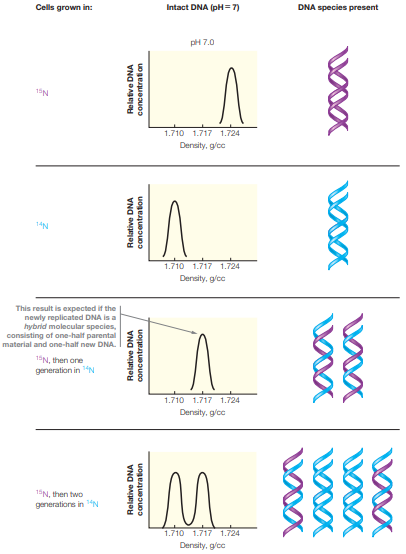Cells grown in: Intact DNA (pH=7) DNA species present pH 7.0 1.710 1.717 1.724 Density, g/cc 14N 1.710 1.717 1724 Density, g/cc This result is expected if the newly replicated DNA is a hybrid molecular species, consisting of one-half parental material and one-half new DNA. 15N, then one generation in "N 1.710 1.717 1.724 Density, g/cc 15N, then two generatione in 1N 1.710 1.717 1.724 Density, g/cc Relative DNA Relative DNA concentration Relative DNA Relafive DNA concentration concentration uogegueouos
Molecular Techniques
Molecular techniques are methods employed in molecular biology, genetics, biochemistry, and biophysics to manipulate and analyze nucleic acids (deoxyribonucleic acid (DNA) and ribonucleic acid (RNA)), protein, and lipids. Techniques in molecular biology are employed to investigate the molecular basis for biological activity. These techniques are used to analyze cellular properties, structures, and chemical reactions, with a focus on how certain molecules regulate cellular reactions and growth.
DNA Fingerprinting and Gel Electrophoresis
The genetic makeup of living organisms is shown by a technique known as DNA fingerprinting. The difference is the satellite region of DNA is shown by this process. Alex Jeffreys has invented the process of DNA fingerprinting in 1985. Any biological samples such as blood, hair, saliva, semen can be used for DNA fingerprinting. DNA fingerprinting is also known as DNA profiling or molecular fingerprinting.
Molecular Markers
A known DNA sequence or gene sequence is present on a chromosome, and it is associated with a specific trait or character. It is mainly used as a genetic marker of the molecular marker. The first genetic map was done in a fruit fly, using genes as the first marker. In two categories, molecular markers are classified, classical marker and a DNA marker. A molecular marker is also known as a genetic marker.
DNA Sequencing
The most important feature of DNA (deoxyribonucleic acid) molecules are nucleotide sequences and the identification of genes and their activities. This the reason why scientists have been working to determine the sequences of pieces of DNA covered under the genomic field. The primary objective of the Human Genome Project was to determine the nucleotide sequence of the entire human nuclear genome. DNA sequencing selectively eliminates the introns leading to only exome sequencing that allows proteins coding.
Refer to Figure, which presents the Meselson–Stahl experiment. DNA molecules can be denatured by high pH, as well as by heat. Suppose that the CsCl gradient centrifugations were run at pH 12, conditions under which DNA strands separate. Sketch the gradient profiles expected for each of the four samples depicted in the figure.

Trending now
This is a popular solution!
Step by step
Solved in 2 steps with 1 images


